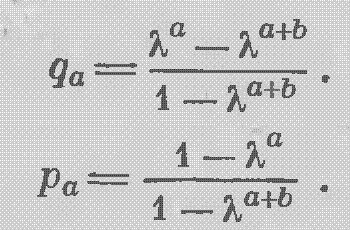Estimate 3s.
And arcsinus with double logarithm for each point to help.
If you remember the principle of maximum likelihood, it might work.
The axiomatics has to be changed.
;)
Take Profit should be achievable but as large as possible and Stop Loss should be unachievable but as small as possible.
SL, B/S and no TP. And what size and where and when to place, open and close is up to everyone, based on many factors.
I'm not talking about the practice of trading, but about theory, that's why I'm considering extreme variants for the sake of the experiment.
Given an EA with random entry, initially set equal stop and profit.
Iteration 1 - the market has made a step in the direction of profit probabilities have changed, let's decrease the probabilities and pull SL up to the market.
Iteration 2 - market has made a step in the direction of the stop the probabilities have changed, we scale probabilities and pull the TP to the market.
If we pull up now the profit and then the stop loss to the market, the probabilities will always equal each other and this trade will return zero results.
For a favorable outcome we need to shift the probability, i.e. pulling one side slower than the other.
How will the probability change if TP is pulled slower than SL?
Для господ чистых практиков перефразируем задачу в пошаговую :
Дано советник с рандомным входом, изначально выставляем равные стоп и профит.
Итерация 1 - рынок сделал шаг в сторону профита вероятности изменились, уровняем вероятности и подтянем СЛ к рынку.
Итерация 2 - рынок сделал шаг в сторону стопа вероятности изменились, уровняем вероятности и подтянем ТП к рынку.
Если подтягивать то профит то стоплосс к рынку то вероятности всегда будут уравниваться и такая торговля даст нулевой исход.
Для благоприятного исхода требуеться сдвинуть вероятность те подтягивать одну из сторон медленнее чем другую.
Как измениться вероятность если ТП подтягивать медленней чем СЛ ?
ITERATION 1 and below... Who says the probabilities are level?
Where did this hypothesis come from?
but I'll put it out there for a while.
Bridge from the middle to the...
if you ask me.
For gentlemen of pure practitioners let's rephrase the problem into a step-by-step one:
We have an EA with random entry, initially we set equal stop and profit.
Iteration 1 - the market has made a step in the direction of profit probabilities have changed, let's decrease the probabilities and pull SL up to the market.
Iteration 2 - market has made a step in the direction of the stop the probabilities have changed, we scale probabilities and pull the TP to the market.
If we pull up now the profit and then the stop loss to the market, the probabilities will always equal each other and this trade will return zero results.
For a favorable outcome we need to shift the probability, i.e. pulling one side slower than the other.
How will the probability change if TP is moved slower than SL?
In general this can only be done for abstractions such as random walks, or more specific - SB with a trend.
For pure SB the probabilities will be inversely proportional to the length to sl and tp. P(SL)=TP/(SL+TP), P(TP)=SL/(SL+TP) - not considering the spread
For SB with a trend it will be more complicated and depends also on the trend component and dispersion (volatility).
в общем виде это можно только для абстракций типа случайного блуждания посчитать, ну или более частные - СБ с трендом.
Для чистого СБ вероятности будут обратно пропорциональны длине до sl и tp. P(SL)=TP/(SL+TP), P(TP)=SL/(SL+TP) - без учета спреда
Для СБ с трендом все будет сложнее и зависит так же от трендовой составляющей и от дисперсии(волатильности).
A vital topic if you ask me.
 where
where  a and b are the distances to TP and SL
a and b are the distances to TP and SL
- Free trading apps
- Over 8,000 signals for copying
- Economic news for exploring financial markets
You agree to website policy and terms of use
hence the problem statement or rather the previously set problem time_open|direction|close time
turns into opening time|direction|(set TP and SL).
Now the essence of the question: what is better: a small_stop loss|big_stopprofit or small_stopprofit|big_stop loss ?
Theoretically the smaller the removal the smaller the loss or profit (by variations),
but the further away the level is, the less likely it will be to be reachable by cumulative.